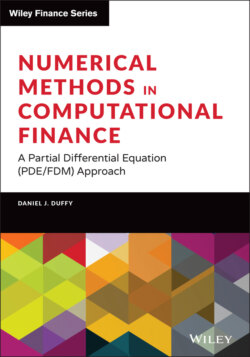Читать книгу Numerical Methods in Computational Finance - Daniel J. Duffy - Страница 14
1.1 INTRODUCTION AND OBJECTIVES
ОглавлениеIn this chapter we introduce a number of mathematical concepts and methods that underlie many of the topics in this book. The most urgent attention points revolve around functions of real variables, their properties and the ways they are used in applications. We discuss the most important topics from real analysis to help us in our understanding of partial differential equations (PDEs). A definition of real analysis is:
In mathematics, real analysis is the branch of mathematical analysis that studies the behavior of real numbers, sequences and series of real numbers, and real functions. Some particular properties of real-valued sequences and functions that real analysis studies include convergence, limits, continuity, smoothness, differentiability and integrability.
Real analysis is distinguished from complex analysis, which deals with the study of complex numbers and their functions.
(Wikipedia)
A related branch of mathematics is calculus, which we learn at school:
Calculus, originally called infinitesimal calculus or ‘the calculus of infinitesimals’, is the mathematical study of continuous change, in the same way that geometry is the study of shape and algebra is the study of generalizations of arithmetic operations.
It has two major branches, differential calculus and integral calculus; the former concerns instantaneous rates of change, and the slopes of curves, while integral calculus concerns accumulation of quantities, and areas under or between curves. These two branches are related to each other by the fundamental theorem of calculus, and they make use of the fundamental notions of convergence of infinite sequences and infinite series to a well-defined limit.
(Wikipedia)
In practice, there is a distinction between calculus and real analysis. Calculus entails techniques (and tricks) to differentiate and integrate functions. It does not discuss the conditions under which a function is continuous or differentiable. It assumes that it is allowed to carry out these operations on functions. Real analysis, on the other hand, does discuss these issues and more; for example:
Continuous functions: How do we recognise them and prove that a function is continuous?
The different kinds of discontinuous functions.
Differential calculus from a real-analysis viewpoint.
Taylor's theorem.
An introduction to metric spaces and Cauchy sequences.
In our opinion, these topics are necessary prerequisites for the rest of this book.
Knowledge of vector (linear) analysis and numerical linear algebra is also a prerequisite for computational finance. To this end, we devote Chapters 4 and 5 to these topics. Finally, complex variables and complex functions (which are at the heart of complex analysis) are introduced in Chapter 16. We use the notation to mean ‘for all’ and to mean ‘there exists’.
